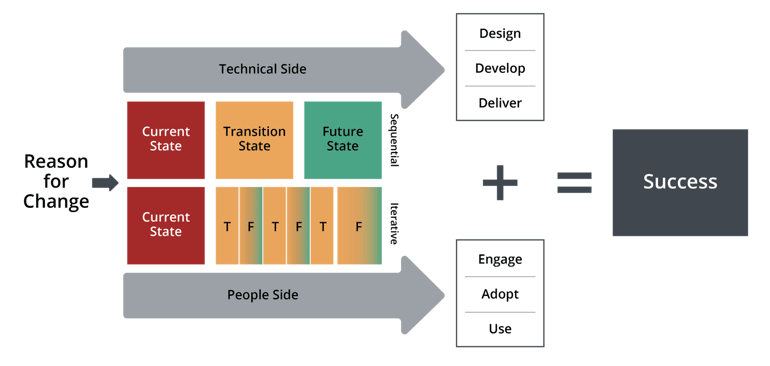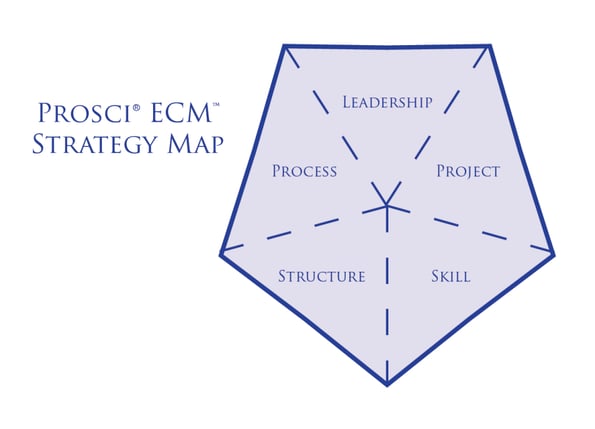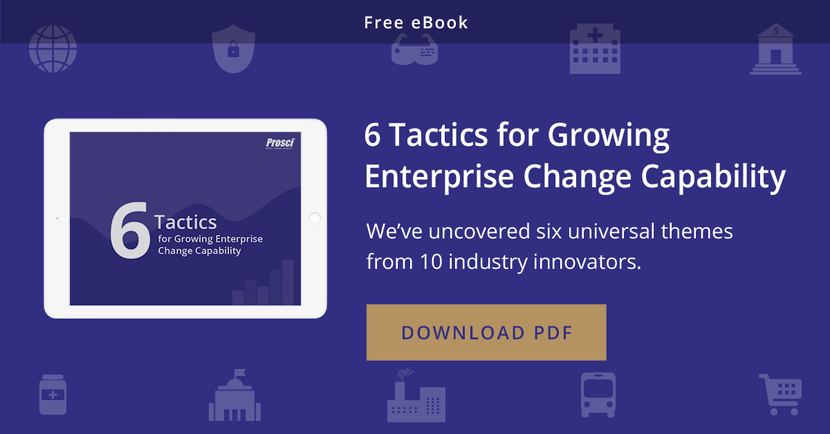A Roadmap for Building Change Management Competency

5 Mins
Updated: February 23, 2024
Published: December 15, 2021

In the coming years, no other competency will be more important to your organization than the ability to manage change effectively. But building the competency to manage change—or enterprise change management—is not like installing a new system or technology. It is a transformation in how the organization operates and leads people. It requires individuals to learn new skills and take on new roles. And it requires a new approach to project changes and initiatives.
The Change-Ready Organization
An organization is successful at building change competency when change management is applied on each and every project, individuals at all levels of the organization have developed the competency to manage change, and change readiness becomes a competitive differentiator. Change management will also be evident in the organization's processes and structure, and visible in the actions and behaviors of executives, senior leaders, people managers, project teams and front-line employees.
Regardless of the change management approach you choose, effectively deploying enterprise change management requires sponsorship, structure and strategy.
Sponsorship
Enterprise change management (ECM) requires sponsorship at the highest levels of an organization.
In all of Prosci's Best Practices in Change Management studies over the past two decades, active and visible sponsorship has been identified as the number one contributor to success. Building the competency to manage change requires the same leadership commitment in terms of strategy, resources and actions.
Structure
One of the most important lessons learned about deploying ECM is that it must be managed as both a project and a change. From the technical-side perspective, the project needs a team, a plan, resources, time frames, and effective project management. From the people-side perspective, the human side must be managed to support and equip people throughout the organization to engage, adopt and use change management principles, processes and tools. For many, "applying change management" is a significant change to how they operate.

Prosci's Unified Value Proposition
Strategy
Every organization is unique, which means the "right" deployment strategy will be too. Prosci research and client observations show that effective approaches should meet your organization's unique needs while balancing additional key tactics.
ECM Deployment Approaches
Prosci's research on building change management competency within an organization offers insights and a roadmap for three common deployment approaches: project-centric, skill-centric and holistic.
1. Project-centric approach
A project-centric approach is often taken when the effort's originator wears more of a "project hat" in the organization, e.g., an experienced project manager, member of the PMO, or leader overseeing several projects in their department. This person tends to have influence over projects and can drive change management into projects first in the organization.
The focus of this approach is to apply change management to a handful of specific projects. This typically involves sequencing and planning to identify the first, most appropriate projects. One way to do that is to begin with a single, major initiative that is highly visible. Another is to attach change management to several projects in one functional area, such as IT, HR or the call center, or to projects within a geographic region.
High-level action steps in a project-centric approach
- Select the first wave of projects to use change management
- Prepare and equip project leaders and change managers in change management for the selected projects
- Prepare and equip the people managers and senior leaders who will execute change management activities
- Implement change management strategies, follow up, and decide on the next wave of projects on which to apply change management
- Easier to get off the ground
- Piggy backs on project management experience
- Creates short-term wins to leverage for future change management rollout
Cons of a project-centric approach
- Senior leaders and people managers can get bombarded as multiple projects engage and pull them in different directions
- No economies of scale in building the initial foundation and understanding in change management
- Not all change that happens in organizations occurs as a well-defined project, and these "non-project" changes miss out on change management benefits

2. Skill-centric approach
A skill-centric approach is often used when the effort's originator has a human resources or training background. In fact, these efforts often originate in HR and focus on developing the leadership competency to manage change. Skill is typically the focus because the originator (e.g., the director of training) has influence and control in the training part of the organization.
The focus of the skill-centric approach is on building skills and competencies to manage change in the organization. While projects may be marginally addressed, the initial focus is training. This approach leverages the fact that senior leaders, people managers, and project team members have specific roles and responsibilities, and training is an effective tool for building skills associated with these roles.
High-level action steps in a skill-centric approach
- Identify "who needs to know what" through a needs assessment for change management focusing, at a minimum, on project teams, senior leaders and people managers
- Align change management into competency models and personal development plans
- Deliver training to targeted groups
Pros of a skill-centric approach
- Creates the groundwork for the individual competencies that ultimately must be evident for the organization to build the competency
- Courses are already developed and ready to roll out or can be customized with minimal effort
- Integrates all key roles in change management, e.g., senior leaders as sponsors and people managers as coaches to employees
Cons of a skill-centric approach
- Competencies are not internalized into core business processes
- Change management may or may not be utilized on key projects and initiatives
- Learning change management without having a specific project to apply the tools can make it academic with less impact
- Can reduce change management to "just another training program"
3. Holistic approach
The project-centric and skill-centric approaches to building change management competency in an organization each have their own merits and potential risks. However, Prosci's research and experience shows that a holistic approach that addresses both areas along with the elements of process and structure will be highly effective when you have sponsorship from the highest level of your organization.
In Prosci's ECM Boot Camp, attendees learn how to begin the process of building change competency and identify their organization's current state. We apply a five-wedge model called the ECM Strategy Map, which identifies five areas where tactics should be developed to improve how the organization manages change. All five areas are important, but the balance will differ for every organization.

Although building enterprise change management competency is a unique journey for every organization, here's what a successful future state looks like in each area of the ECM Strategy Map:
Leadership
- All senior leaders are competent in their roles as sponsors of change
- Each project has an assigned primary sponsor at the right level for that project
- Senior leaders are active and visible in their sponsorship activities
Project
- All projects include change management on a regular basis
- Project plans and change management plans are fully integrated for each project
Skill
- All change managers are certified in change management
- All project teams and project support functions are trained in change management
- All senior leaders consistently demonstrate behaviors of effective change sponsorship
- All people managers are trained and competent at managing change with their employees and coaching them through change
Process
- A standard change management methodology is in place
- Change management and project management processes are both under a process management and continuous improvement program
- The funding process for new projects accounts for change management risks and requires change management plans
- Regular reviews are conducted with the leadership team on progress of change management deployment and on project portfolio management results
Structure
- A team is designated for managing change management deployment
- The change management team or group reports to the primary sponsor (as high as possible in the organization, given the enterprise nature of the program)
- Tools and templates are available throughout organization
- Project portfolio management is part of strategy work for the organization
Pros of a holistic approach
- Fully integrated program with highest likelihood of success
- Leverages leadership commitment to the change
Cons of a holistic approach
- Requires more time and resources up front
- Requires significant leadership presence
Deploying A Holistic Approach to ECM
Building ECM competency requires sponsorship, structure and strategy. Although a project-centric approach or skill-centric approach can make sense for certain organizations, a holistic approach will yield the best outcomes when you have the leadership support you need. A holistic approach combines the pros of both skill-centric and project-centric approaches while minimizing the risks by applying more structure and process.


